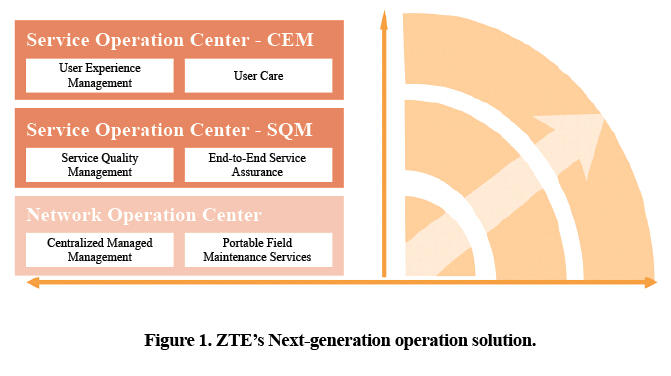Building New-Value OAM to Meet the Mobile Internet Challenges
According to data released by Ministry of Industry and Information Technology of the People's Republic of China, the volume of text messages sent during the 2014 Spring Festival fell by more than 40% compared to the same period in 2013. This was the first decline in more than a decade. So how are people now extending their New Year's greetings if they are not sending short messages? The answer is certainly not phone calls. Statistics provided by mobile operators shows that the average daily outgoing call duration during the 2014 Spring Festival was only three quarters that of non-holiday periods and shorter than the average daily call duration the 2013 Spring Festival. The answer lies in the use of smartphone apps such as Wechat, QQ, or Laiwang. Eight days after New Year's Eve (according to the lunar calendar), the average daily traffic of a mobile user was 46.6 MB, an increase of 63% compared with the same period in 2013. Revenue from traditional voice and SMS dropped sharply for operators, and revenue from data has not compensated for this shortfall. At the same time, operators are investing heavily in expanding the capacity of their networks to handle more traffic. The cost of managing these networks has also increased.
With the evolution of internet services and smart mobile terminals, traditional telecom operators are being squeezed between existing rivals (other operators) and emerging competitors (OTT providers). How can operators succeed in transforming themselves?
Data services have drawn high and wide attention in the internet era. Therefore, operators should focus on the guaranteed QoS of data services, pipe control, QoS-based pricing, and interest sharing. To achieve this goal, priority should be given to the following three aspects.
● guarantee. Data service operation is based on a high-quality, high-performance network, which ensures a transparent, manageable, controllable OTT application quality and customer experience on the mobile internet.
● partnership. Operators should establish partnerships with OTT providers and content providers to create a competitive environment, promote the development of high-bandwidth and large-data-volume applications, and enhance the central role of the pipe to raise the players’ awareness of the importance of service quality.
● innovation. Operators should proactively shift their focus from network performance to customer experience. Moreover, operators should exploit the value of the data in the pipes.
As a leading OAM solution provider, ZTE offers next-generation operation solution for telecom operators in transition (Fig. 1). This business value-driven and customer experience-centric solution builds a top-down OAM system to make customer experience more transparent, controllable and manageable. It includes a centralized OAM system to promote efficiency and reduce costs as well as a customer experience-centric OAM system to manage service quality and user perception.

Centralized OAM System, Promoting Efficiency
As network technologies develop, increasing networks concentration requires a centralized OAM system. Operators can improve centralization in the following ways to promote efficiency and lower costs.
● optimize the OAM system. This involves building an OAM system capable of centralized monitoring and management. With standard structure and procedures and centralized support system, the OAM system make OAM flat, centralized, intelligent and visible. This improves network quality and OAM efficiency.
● innovate the OAM arrangement. Innovate the OAM arrangement to centralize OAM management, provide remote access to control network statuses in real time, and coordinate with local and remote OAM engineers to improve efficiency and reduce costs.
● re-formulate the OAM processes. Review and optimize core processes to provide standardized, modular, coordinated end-to-end services.
● reconstruct the OSS platform. Reconstruct stovepipe OAM systems provided by third parties and integrate them into a unified OSS platform for end-to-end OAM, so as to satisfy emerging customer requirements and improve efficiency.
In the network layer, the next-generation operation solution launched mobile OAM management service and centralized OAM management service. In addition, it achieved four transitions of flatness, centralization, automation and visualization, and it committed to efficiency promotion and intensive transformation.
Customer Experience-Centric OAM System, Increasing Revenues
In the internet era, traditional network performance-centric OAM systems no longer meet operator OAM requirements. Operators need a new customer experience-centric OAM solution to manage service quality and user perception.
● re-establish an evaluation index system by building a KPI-KQI-CEI index system for effective evaluation on data service quality and user perception.
● build a service operation center (SOC) by restructuring the existing OAM system architecture, the process system, and the management platform for service quality and customer experience, the next-generation operation solution can locate network faults and solve service problems from top to bottom.
● service operation and customer experience management. Implement an end-to-end management mechanism that involves monitoring, analyzing, and handling service quality to transform the original OAM system into a customer experience-centric OAM system and offer transparent, manageable and controllable customer experience.
In the service layer, the next-generation operation solution launched an OAM management service solution and helps operators build an SOC. By transforming from network performance-centric to customer experience-centric, it maximizes business values and increases revenues.
ZTE has collaborated closely with many telecom operators, including China Mobile, China Telecom, China Unicom, Telenor Europe, Hutchison Austria, MTN Nigeria and CMpak, and has helped them to take the initiative in the new round of transformation.